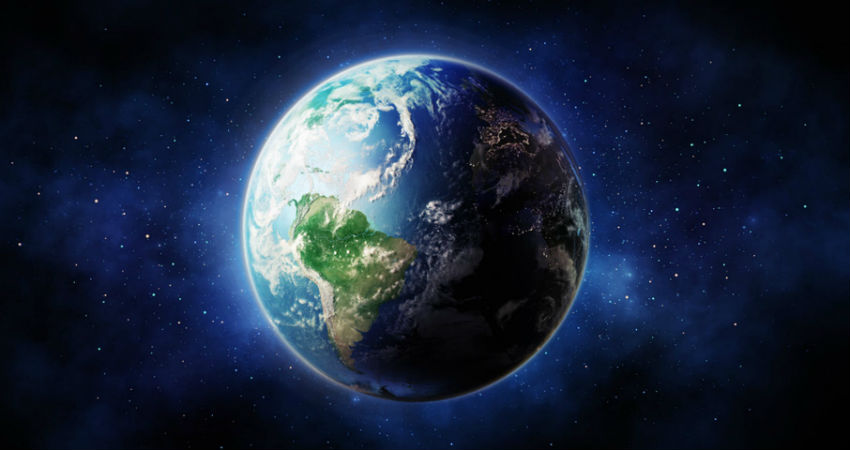
There has been chatter about the ‘Earth under repair’. With Coronavirus taking over the world first with China where NASA saw a definite change in the air over the most polluted SEZ, to Venice where the canals are green with dolphins swimming to the shore and now, we come to India.
There have been some sittings of dolphins near the Juhu beach, the Twitterati has gone berserk showing clean beaches, blue skies and birds that they never saw chirping outside their windows. We also did our work to see if this has worked for India. We are proud to say that we have invested the past year in creating our network of air pollution sensors. Skymet: Total 51 AQM monitoring stations are considered and data analysis was done for the duration from 15th Mar 2020 to 30th Mar 2020.
Here’s the data that we compared from our sensors to see a comparative change in how air pollution has gone done as compared to last year and around the same time. To understand the Particulate matter (PM) trend due to COVID-19 impact in NCR areas, PM concentration comparison was done based on the data monitored by Central Pollution Control Board (CPCB) and Skymet Weather Services. Nearest reference CPCB- Continuous Ambient Air Quality Monitoring System (CAAQMS) station was considered and data analysis was done for the duration 15 Mar to 30th Mar 2019. Here, Janata Curfew, which started on March 22, 2020, is presented in Figure 1. The PM concentration records of 2019 and 2020 percent reduction have been calculated and shown below.
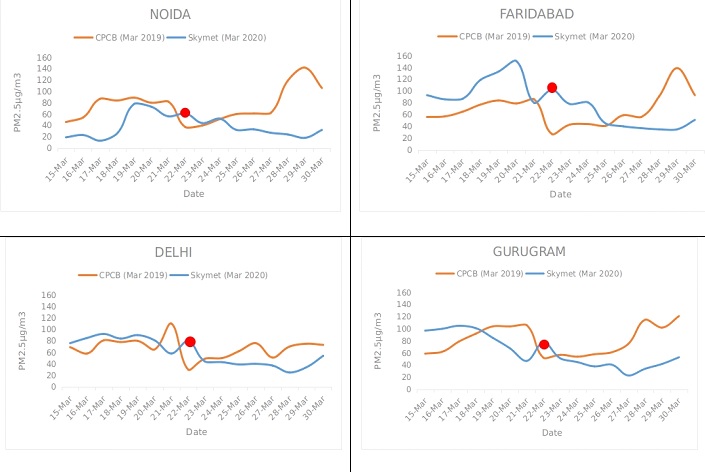
Even when we compare different time phases of the day, to compare peak to non- peak hours we see that NCR regions of Noida, Faridabad, Delhi and Gurugram areas showed dropdown in PM concentration trend after 22/03/2020.
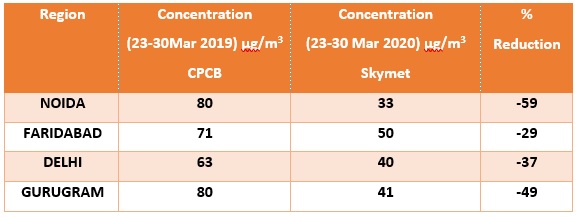
From Table 1, PM concentration comparison between 2019 and 2020 March showed that in 2019 the highest mean PM concentration levels are observed in Noida and Gurugram have been reduced to -59% and -49% in 2020. Before the lockdown, the daily PM concentration was above 80 μg/m3 in all NCR regions and after the lockdown on 22/03/2020 i.e. on Sunday there was a steady drop in PM levels which was observed till 29/03/2020. During the lockdown the Diurnal variation it can be said that peaks are observed during morning hours in Faridabad, Delhi and Gurugram region. Lowest concentration levels were observed in Noida during all hours of the week.
Figure 2: Diurnal Variation pattern of PM concentration levels before the lockdown phase and during the lockdown phase
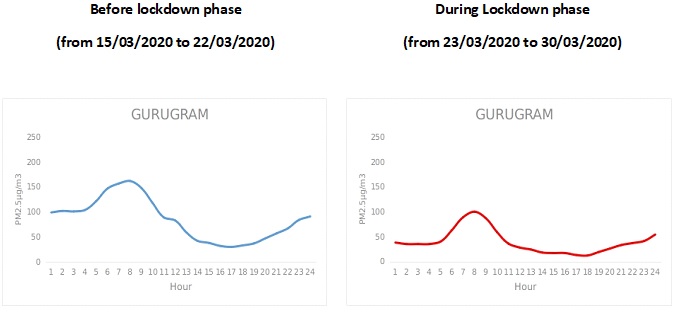
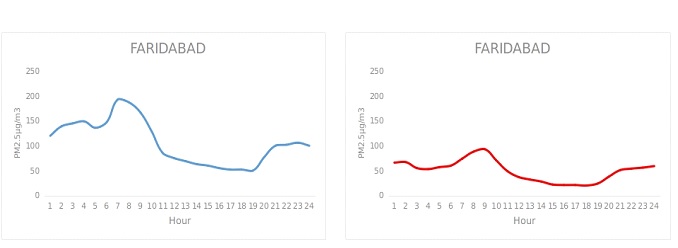


So what happens after April 15? Even though the pollution levels have gone down, but these are only PM levels. Scientifically, if you notice cars are the biggest polluters. But I also feel that just looking at PM or particulate matter is looking at the problem halfway, all the observatories that every one of us has should be the type of pollutants – SOX, NOX. Once, when we do this, we would know what the right polluter and what point in time is. So, when stubble burning happens then the concentration of gases would be different than from pollution levels at peak traffic levels.
Naturally, there has been a lot of panic over how the new disease spreads from the surfaces of various objects. Many people have stopped subscribing to print newspapers. Others have stopped having meals delivered home by restaurants. People are even washing currency notes. When the lockdown is eased, we will still have to deal with the virus.
"You have to touch the infected surface and then touch your nose, eyes or mouth for the virus to enter your respiratory tract. It is important to remember that SARS-CoV-2 has no way of infecting you if it cannot get inside your body. However, the exact extent to which surfaces contribute to the spread isn’t known, and there is reason for uncertainty. What we do know from a research study is that there is an impact of temperature on the stability of SARS-CoV-2 on surfaces. At 22°C, the virus degraded greatly after seven days and couldn’t be detected after two weeks. At 37°C, almost all of the virus degraded after one day. Ramping temperatures up speeds up the process of degradation. At 56°C, 30 minutes was all it took to get rid of most of the virus, while at 70°C, it only took 5 minutes. This is preliminary work that needs to be verified, but it is in line with what has been seen with other similar viruses." - Anirban Mahapatra is a microbiologist and assistant director at the American Chemical Society.
So what happens after April 15, 2020? Will pollution go back to its existing level, will Coronavirus bounce back? I agree with Anirban, the solution needs to come from within us. If you see Ecuador is suffering and has become the epicenter of COVID – 19 for South America even though the temperature is Hot and Humid. Someone will come up and say that Ecuador has no infrastructure or medical facility, but we should be cautious and not be so happy when summer hits India.
We need to keep continuing good habits, follow carpool and reduce our carbon footprint. This will not only help the environment but also all of us in keep us safe from factors affecting our lives. Follow the 5 tips:
- Wash hands after you have touched a surface
- Do not touch your face and mouth without washing your hands
- Wash your hands for 20 seconds multiple times a day
- Cover your face when you go out of the house
- Stay home and stay safe


